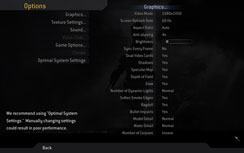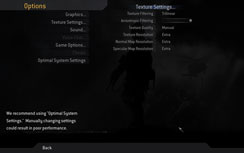AMD ATI Radeon HD 4870 X2
Written by Tim Smalley
August 13, 2008 | 08:06
Tags: #4870 #card #crossfire #hd #multi-gpu #performance #r700 #radeon #review #rv770 #sideport #x2

Call of Duty 4: Modern Warfare
Publisher: ActivisionCall of Duty 4: Modern Warfare is different to all previous Call of Duty games, as it moves the action out of the World War II era and into the modern day. We have used the full version of the game with the 1.5 patch applied.
The game runs on a proprietary engine, which includes features like true world dynamic lighting, HDR lighting, dynamic shadowing and depth of field. Unlike most triple-A games that were launched late in 2007, Call of Duty 4: Modern Warfare only uses a DirectX 9.0 renderer and, given the realistic nature of the graphics, it proves that there's still life left in the old dog!
For our gameplay testing, we did a 90 second manual run through in the second mission of the game. All of the in-game settings were set to their maximum values, including texture details which were configured to 'Extra'. The 'Dual Video Cards' option was enabled for the multi-GPU configurations, but was disabled for all single GPU cards.
Finally, anti-aliasing and anisotropic filtering were controlled from inside the game.
Call of Duty 4
1680x1050, 4xAA, 16xAF, DX9, Maximum Detail
- ATI Radeon HD 4870 X2
- Nvidia Geforce 9800 GX2
- Nvidia GeForce GTX 280
- ATI Radeon HD 4870
- ATI Radeon HD 4850
- Nvidia GeForce GTX 260
- Nvidia GeForce 9800 GTX+
- Nvidia GeForce 9800 GTX
- ATI Radeon HD 3870 X2
- Nvidia GeForce 8800 GT
- ATI Radeon HD 3870
-
-
99.3
-
56.0
-
-
-
95.5
-
60.0
-
-
-
79.3
-
43.0
-
-
-
75.8
-
51.0
-
-
-
66.5
-
43.0
-
-
-
65.6
-
38.0
-
-
-
63.7
-
36.0
-
-
-
57.7
-
34.0
-
-
-
49.4
-
32.0
-
-
-
49.0
-
27.0
-
-
-
41.3
-
27.0
-
0
25
50
75
100
Frames Per Second
-
Average
-
Minimum
Call of Duty 4
1920x1200, 0xAA, 16xAF, DX9, Maximum Detail
- Nvidia Geforce 9800 GX2
- ATI Radeon HD 4870 X2
- Nvidia GeForce GTX 280
- Nvidia GeForce GTX 260
- ATI Radeon HD 4870
- Nvidia GeForce 9800 GTX+
- Nvidia GeForce 9800 GTX
- ATI Radeon HD 4850
- ATI Radeon HD 3870 X2
- Nvidia GeForce 8800 GT
- ATI Radeon HD 3870
-
-
123.6
-
68.0
-
-
-
108.4
-
63.0
-
-
-
105.4
-
57.0
-
-
-
87.9
-
48.0
-
-
-
87.7
-
59.0
-
-
-
87.1
-
49.0
-
-
-
78.1
-
44.0
-
-
-
76.7
-
47.0
-
-
-
64.3
-
39.0
-
-
-
58.0
-
36.0
-
-
-
56.7
-
35.0
-
0
25
50
75
100
125
Frames Per Second
-
Average
-
Minimum
Call of Duty 4
1920x1200, 4xAA, 16xAF, DX9, Maximum Detail
- ATI Radeon HD 4870 X2
- Nvidia GeForce GTX 280
- Nvidia Geforce 9800 GX2
- ATI Radeon HD 4870
- Nvidia GeForce GTX 260
- ATI Radeon HD 4850
- Nvidia GeForce 9800 GTX+
- Nvidia GeForce 9800 GTX
- Nvidia GeForce 8800 GT
- ATI Radeon HD 3870 X2
- ATI Radeon HD 3870
-
-
88.4
-
48.0
-
-
-
80.7
-
40.0
-
-
-
77.5
-
28.0
-
-
-
66.0
-
53.0
-
-
-
57.0
-
34.0
-
-
-
55.1
-
35.0
-
-
-
53.1
-
32.0
-
-
-
48.7
-
29.0
-
-
-
42.0
-
25.0
-
-
-
39.1
-
24.0
-
-
-
35.1
-
21.0
-
0
10
20
30
40
50
60
70
80
90
Frames Per Second
-
Average
-
Minimum
Call of Duty 4
2560x1600, 0xAA, 16xAF, DX9, Maximum Detail
- Nvidia Geforce 9800 GX2
- ATI Radeon HD 4870 X2
- Nvidia GeForce GTX 280
- Nvidia GeForce GTX 260
- Nvidia GeForce 9800 GTX+
- ATI Radeon HD 4870
- Nvidia GeForce 9800 GTX
- ATI Radeon HD 4850
- ATI Radeon HD 3870 X2
- Nvidia GeForce 8800 GT
- ATI Radeon HD 3870
-
-
95.2
-
54.0
-
-
-
87.0
-
45.0
-
-
-
74.9
-
35.0
-
-
-
63.6
-
36.0
-
-
-
61.1
-
34.0
-
-
-
58.2
-
39.0
-
-
-
53.5
-
30.0
-
-
-
50.9
-
29.0
-
-
-
43.5
-
28.0
-
-
-
43.0
-
26.0
-
-
-
36.7
-
23.0
-
0
25
50
75
100
Frames Per Second
-
Average
-
Minimum
Call of Duty 4
2560x1600, 2xAA, 16xAF, DX9, Maximum Detail
- Nvidia Geforce 9800 GX2
- ATI Radeon HD 4870 X2
- Nvidia GeForce GTX 280
- Nvidia GeForce GTX 260
- ATI Radeon HD 4870
- Nvidia GeForce 9800 GTX+
- Nvidia GeForce 9800 GTX
- ATI Radeon HD 4850
- Nvidia GeForce 8800 GT
- ATI Radeon HD 3870 X2
- ATI Radeon HD 3870
-
-
66.5
-
39.0
-
-
-
65.1
-
34.0
-
-
-
56.3
-
32.0
-
-
-
44.3
-
28.0
-
-
-
44.3
-
29.0
-
-
-
41.8
-
26.0
-
-
-
39.4
-
25.0
-
-
-
36.2
-
22.0
-
-
-
35.0
-
20.0
-
-
-
32.8
-
20.0
-
-
-
21.4
-
14.0
-
0
10
20
30
40
50
60
70
Frames Per Second
-
Average
-
Minimum
Call of Duty 4
2560x1600, 4xAA, 16xAF, DX9, Maximum Detail
- ATI Radeon HD 4870 X2
- Nvidia GeForce GTX 280
- Nvidia Geforce 9800 GX2
- ATI Radeon HD 4870
- Nvidia GeForce GTX 260
- ATI Radeon HD 4850
- Nvidia GeForce 9800 GTX+
- Nvidia GeForce 9800 GTX
- Nvidia GeForce 8800 GT
- ATI Radeon HD 3870 X2
- ATI Radeon HD 3870
-
-
61.8
-
33.0
-
-
-
49.0
-
29.0
-
-
-
43.8
-
16.0
-
-
-
40.3
-
18.0
-
-
-
39.5
-
24.0
-
-
-
35.2
-
21.0
-
-
-
35.0
-
20.0
-
-
-
33.6
-
20.0
-
-
-
29.0
-
15.0
-
-
-
24.2
-
15.0
-
-
-
20.6
-
12.0
-
0
10
20
30
40
50
60
Frames Per Second
-
Average
-
Minimum
There are quite a few scenarios here where the graphics load just isn't enough to keep the Radeon HD 4870 X2's 1,600 stream processors occupied. When Anti Aliasing is disabled, we see Nvidia's previous flagship GeForce 9800 GX2 stealing the performance lead from both the 4870 X2 and GeForce GTX 280 and even with 4xAA 16xAF applied at 1,920 x 1,200, the Radeon HD 4870 X2 isn't stretching its legs.
In fact, it's not until you hit 2,560 x 1,600 4xAA 16xAF that you really start to see the 4870 X2 coming into its own - at this setting, AMD's sizzler is a good 25 percent faster than its nearest competitor, which just so happens to be the GeForce GTX 280. No amount of partner overclocking is going to make up that deficit.











Want to comment? Please log in.